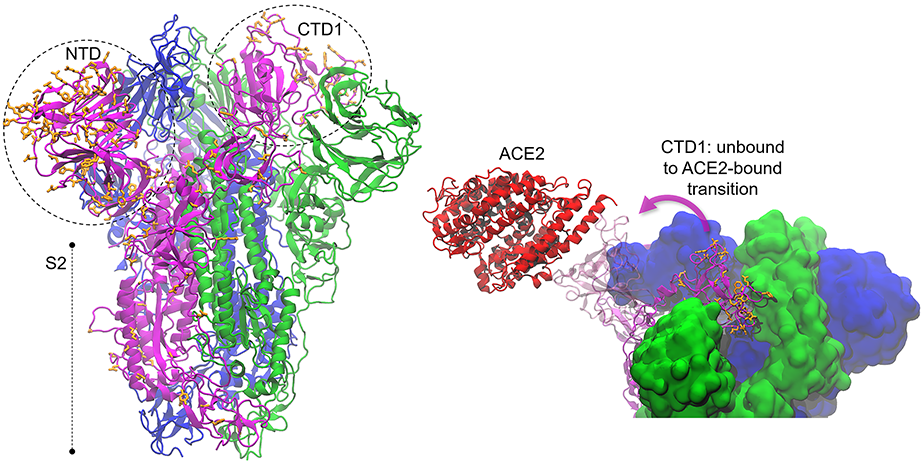Spike glycoprotein

Download Simulations
The spike glycoprotein (S) is the main promoter of virus entry into host cells. These highly glycosylated proteins protrude from the viral surface to interact with the host cell receptor(s). The receptor binding domain of SARS-CoV-2 S harbors many non-conservative substitutions relative to SARS-CoV-1 S. Understanding structure-dynamics relationships in S-receptor complexes can be of key importance to develop effective drugs targeting this interaction and to unveil the pathways of infection by SARS-CoV-2.
Narrative
The spike glycoprotein (S) is the main promoter of virus entry into host cells. These highly glycosylated proteins protrude from the viral surface to interact with the host cell receptor(s). The interaction with the host receptor triggers large conformational changes that exposes proteolytic cleavage sites in S. Shedding of S1 subunit (the “cap” of S) with the action of proteases is essential to start the fusion of viral and host cell membranes. The receptor binding domain of SARS-CoV-2 S harbors many non-conservative substitutions relative to SARS-CoV-1 S. Our molecular dynamics simulations indicate that these substitutions considerably affect the conformational flexibility the receptor binding domain and, consequently, S-receptor complex compactness. Understanding structure-dynamics relationships in S-receptor complexes can be of key importance to develop effective drugs targeting this interaction. Additionally, together with gene expression data analysis, the simulations support that ACE can work as a secondary receptor for SARS-CoV-1, what may enhance the respiratory pathway of infection in SARS relative to COVID-19. These observations are extensively discussed in our manuscript (in review), in which the molecular structure analysis of S protein is integrated with information from a variety of data types and scales (from atoms, alleles, transcripts, proteins, protein complexes, cells, tissues, organs and individuals to population) in a Systems Biology approach to provide mechanistic insight into the route of infection and spread of SARS-CoV-2 in the human body.

